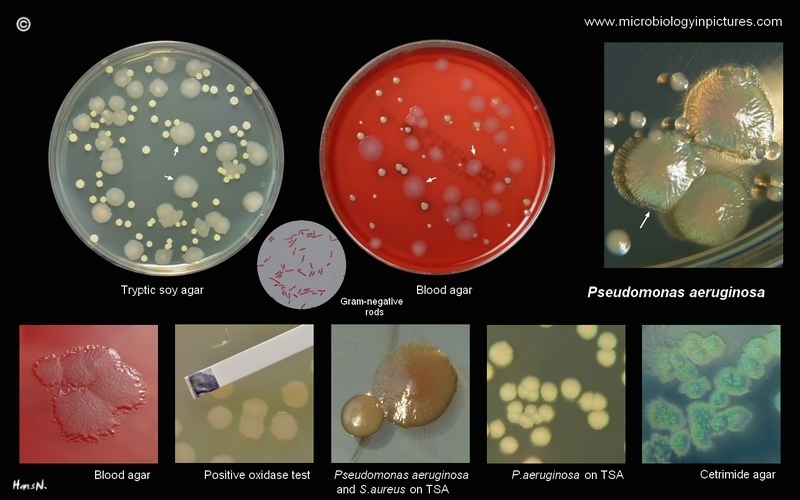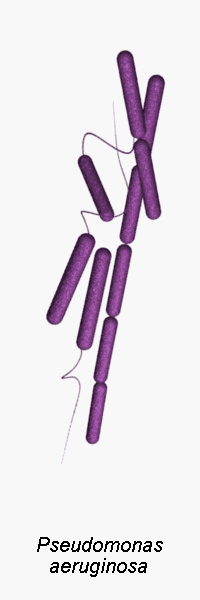Pseudomonas aeruginosa


Pseudomonas aeruginosa is a Gram-negative, rod-shaped, motile organism (polar flagella) which characteristically produce water-soluble pigments which diffuse through the medium. The best known are pyocyanin (blue-green), pyoverdine (yellow-green, fluorescent), and pyorubin (red-brown, produced by a small proportion of strains). It is commonly found free living in moist environments but is also a pathogen of plants, animals, and humans.
Pseudomonas aeruginosa is often preliminarily identified by its typical odor in vitro. The smell is described as grape-like, tortilla-like or "Philadelphus coronarius-like" (production of aminoacetophenone). It is not an active fermenter of carbohydrates and produces acid, but no gas, in glucose and is lactose-negative. The oxidase and catalase test for P.aeruginosa are positive.
Although an aerobic atmosphere is necessary for optimal growth, most strains will multiply slowly in an anaerobic environment if nitrate is present as a hydrogen acceptor. It is able to grow at 42°C. The combination of pyocyanin production and the ability to grow at 42°C is sufficient to distinguish P.aeruginosa from other Pseudomonas spp. (e.g., P.fluorescens, P.putida, P.stutzeri, P.putrefaciens). Certain strains of P.aeruginosa may not produce pyocyanin.
Pseudomonas aeruginosa is an opportunistic pathogen that infects burns, wounds, surgical incisions and sites of catheterization. It is the most common cause of infections of burn injuries and of the outer ear (otitis externa). It can, in rare circumstances, cause community-acquired pneumonias, as well as ventilator-associated pneumonias.
P. aeruginosahas has immense potential to develop resistance against antibiotic as is evident from the fact that its genome contains the largest known resistance island with more than 50 resistance genes (Wikipedia).
This is an "antibiotic paradox" because the very first antibiotic to be discovered in the modern world, was pyocyanase, discovered in 1888 by E. de Freudenreich. It was a mixture of several antibacterially active substances: pyocyanin, 1-hydroxyphenazine and an oily fraction. This natural antibiotic was able to kill typhoid, diphtheria and plague bacteria.
Pyocyanase has been produced commercially, but unfortunately it was unstable and toxic.
(pyocyanin and 1-hydroxyphenazine are also antifungal agents active against Candida albicans and Aspergillus fumigatus; Kerr J R et al., 1999).
Pseudomonas aeruginosa colonies on blood agar












Pseudomonas aeruginosa on tryptic soy agar















Pseudomonas aeruginosa on MacConkey agar



Pseudomonas aeruginosa on Endo agar


Pseudomonas aeruginosa on cetrimide agar






Pseudomonas aeruginosa on various cultivation media



Pseudomonas aeruginosa identification

Pseudomonas aeruginosa Gram stain


Pseudomonas aeruginosa SEM




Useful Links
WIKIPEDIACENTERS FOR DISEASE CONTROL AND PREVENTION (CDC)
Todar's Online Textbook of Bacteriology
Microbe Wiki (the student-edited microbiology resource)
www.antimicrobe.org
www.vetbact.org
Merck Manual
